
Messier 38 or M38, also known as NGC 1912 or Starfish Cluster, is an open cluster of stars in the constellation of Auriga. It was discovered by Giovanni Batista Hodierna before 1654 and independently found by Le Gentil in 1749. The open clusters M36 and M37, also discovered by Hodierna, are often grouped together with M38. Distance is about 1.066 kpc (3,480 ly) away from Earth. The open cluster NGC 1907 lies nearby on the sky, but the two are most likely just experiencing a fly-by, having originated in different parts of the galaxy.

NGC 2360 is an open cluster in the constellation Canis Major. It was discovered on 26 February 1783 by Caroline Herschel, who described it as a "beautiful cluster of pretty compressed stars near 1/2 degree in diameter". Her notes were overlooked until her brother William included the cluster in his 1786 catalogue of 1000 clusters and nebulae and acknowledged her as the discoverer. The cluster lies 3.5 degrees east of Gamma Canis Majoris and less than one degree northwest of the eclipsing binary star R Canis Majoris; it has a combined apparent magnitude of 7.2. It is 13 arc minutes in diameter. By the western edge of the cluster is the unrelated star, 5.5-magnitude HD 56405.

NGC 3766 is an open star cluster in the southern constellation Centaurus. It is located in the vast star-forming region known as the Carina molecular cloud, and was discovered by Nicolas Louis de Lacaille during his astrometric survey in 1751–1752. At a distance of about 1745 pc, the cluster subtends a diameter of about 12 minutes of arc.

NGC 6522 is a globular cluster in the constellation Sagittarius. It is apparent magnitude 8.3, and diameter 16.4 arc minutes, and class VI with stars 16th magnitude and dimmer. It was discovered by William Herschel on June 24, 1784. It is centered in a region of the sky known as Baade's Window.
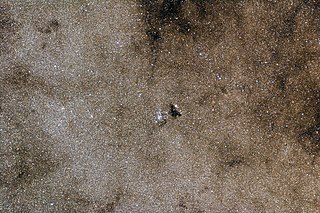
NGC 6520 is an open cluster in the constellation Sagittarius, superimposed upon the Large Sagittarius Star Cloud. It is magnitude 9.0, diameter 5 arc minutes and class G. It has about 25 stars of magnitude 9 to 12. The dark nebula Barnard 86 lies near its western edge.

NGC 6569 is a globular cluster in the constellation Sagittarius. It has an apparent magnitude of about 9.5, and an apparent diameter of 7 arc minutes, and class VIII with stars of magnitude 15 and dimmer. It is about 2 degrees south east of Gamma2 Sagittarii. The globular cluster was discovered in 1784 by the astronomer William Herschel with his 18.7-inch telescope and was catalogued later in the New General Catalogue.

NGC 1466 is the New General Catalogue designation for a globular cluster in the deep southern constellation of Hydrus. It is located in the outskirts of the Large Magellanic Cloud, which is a satellite galaxy of the Milky Way. The object was discovered November 26, 1834 by English astronomer John Herschel. John Dreyer described it as "pF, pS, iR, glbM, *7 f", meaning "pretty faint, pretty small, irregular round, gradually a little brighter middle, with a 7th magnitude star nearby". When using a small telescope, this is a "faint, small, unresolved and difficult" target with an angular size of 1.9 arc minutes. It has an integrated visual magnitude of 11.4.

NGC 1871 is an open cluster associated with an emission nebula located in the Dorado constellation within the Large Magellanic Cloud. It was discovered by James Dunlop on November 5, 1826. Its apparent magnitude is 10.21, and its size is 2.0 arc minutes.

NGC 1873 is an open cluster associated with an emission nebula located in the Dorado constellation within the Large Magellanic Cloud. It was discovered by James Dunlop on September 24, 1826 and rediscovered by John Herschel on January 2, 1837. Its apparent magnitude is 10.4, and its size is 3.50 arc minutes.

NGC 1929 is an open cluster associated with the emission nebula located within the N44 nebula in the Dorado constellation and part of the Large Magellanic Cloud. It was discovered by James Dunlop on August 3, 1826. Its apparent magnitude is 14.0, and its size is 0.8 arc minutes.

NGC 1624, also known as Sh2-212 in the Sharpless catalog, is a very young open cluster in the constellation Perseus inside an emission nebula. It was discovered by German-British astronomer William Herschel in 1790. NGC 1624 is about 20,000 ly from Earth, and latest estimates give it an age of less than 4 million years. Its apparent magnitude is 11.8, and apparent diameter is about 3.0 arc minutes. Its celestial location is right ascension (α) 04h 40m 36.0s and declination (δ) +50° 27′ 42″. It is potentially an area of massive star formation.

NGC 2002 is an open cluster located in the Dorado constellation and is part of the Large Magellanic Cloud. It was discovered by James Dunlop on September 24, 1826. Its apparent magnitude is 10.1, and its size is 2.0 arc minutes.
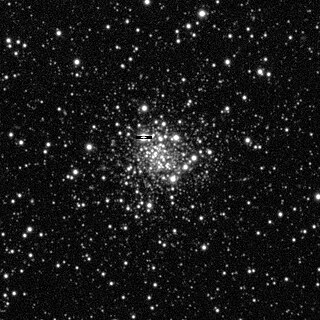
NGC 1997 is an open cluster located in the Dorado constellation which is part of the Large Magellanic Cloud. It was discovered by John Herschel on November 30, 1834. Its apparent magnitude is 13.43 and its size is 1.80 arc minutes.
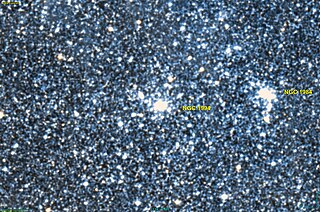
NGC 1994 is an open cluster in the Dorado constellation which is located in the Large Magellanic Cloud. It was discovered by John Herschel on 16 December 1835. It has an apparent magnitude of 9.8 and its size is 0.60 arc minutes.
NGC 1986 is an open cluster which is located in the Mensa constellation which is part of the Large Magellanic Cloud. It was discovered by James Dunlop on September 27, 1826. It has an apparent magnitude of 11.31 and its size is 2.80 by 2.40 arc minutes.

NGC 1983 is an open cluster associated with an emission nebula which is located in the Dorado constellation and part of the Large Magellanic Cloud. It was discovered by John Herschel on 11 November 1836. It has an apparent magnitude of 9.9 and its size is 1.0 arc minutes.
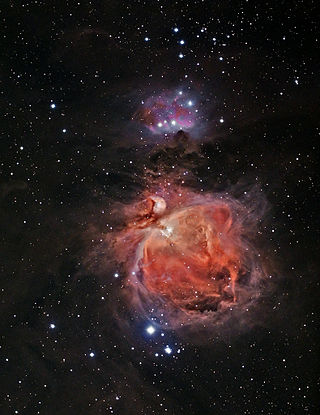
NGC 1981 is an open cluster which is located in the constellation Orion. It was discovered by John Herschel on 4 January 1827. Its apparent magnitude is 4.2 and its size is 28.00 arc minutes. It lies to the north of the Orion Nebula, separated from it by the Sh2-279 region containing NGC 1973, 1975, and 1977.
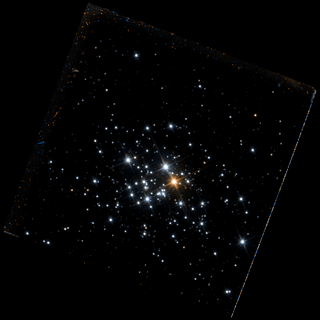
NGC 1984 is an open cluster associated with an emission nebula, it is located in the constellation Dorado in the Large Magellanic Cloud. It was discovered by John Herschel on 16 December 1835. The apparent magnitude is 9.9 and its size is 1.50 by 1.20 arc minutes.
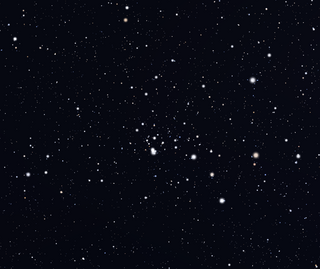
NGC 957 is a loosely bound open cluster located in the constellation Perseus. It has an apparent magnitude of 7.6 and an approximate size of 11 arc-minutes. It is young at less than 11 million years old.
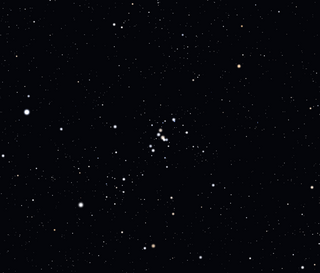
NGC 1662 is a loosely bound open cluster located in the constellation Orion. It has an apparent magnitude of 7.6 and an approximate size of 20 arc-minutes.



















